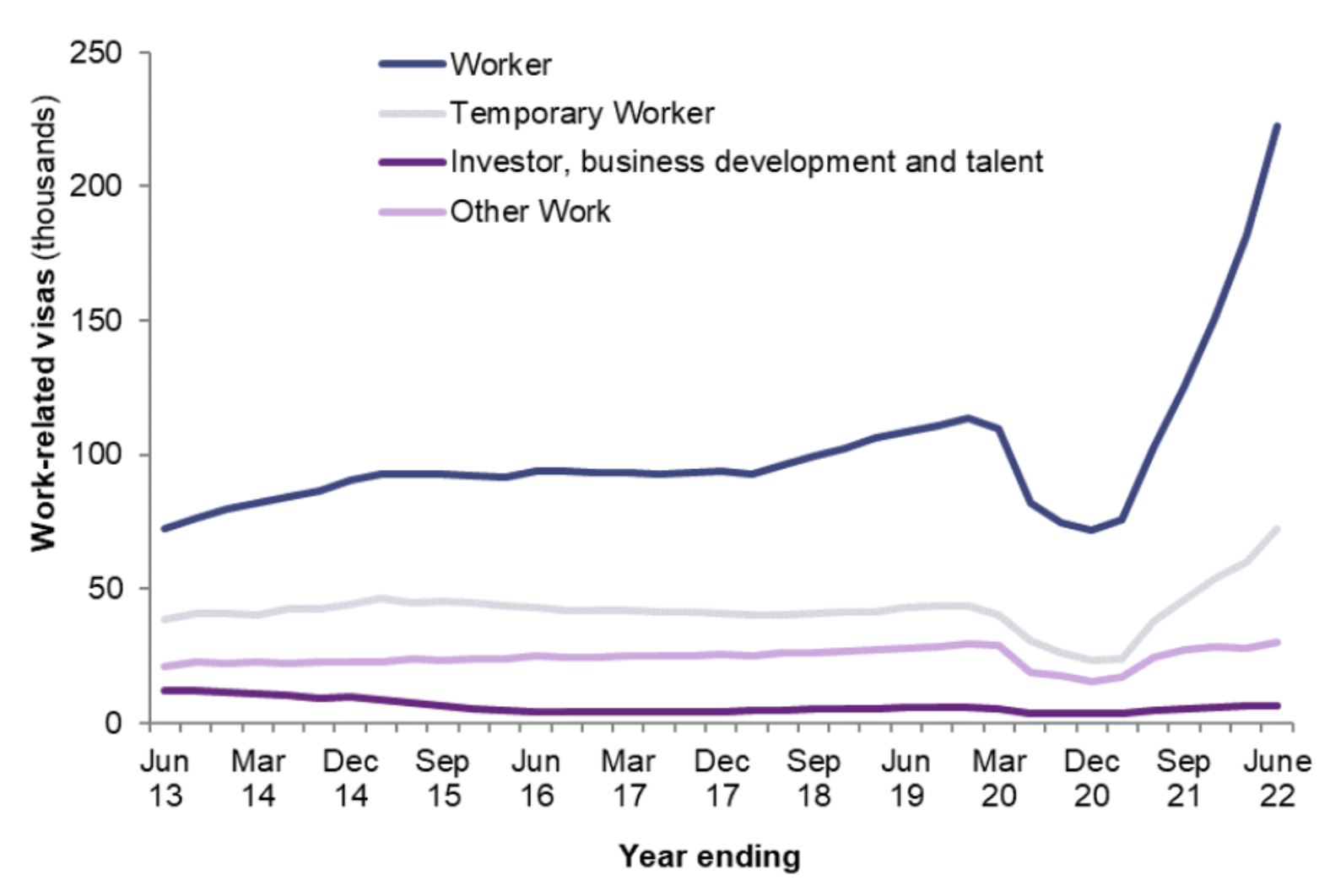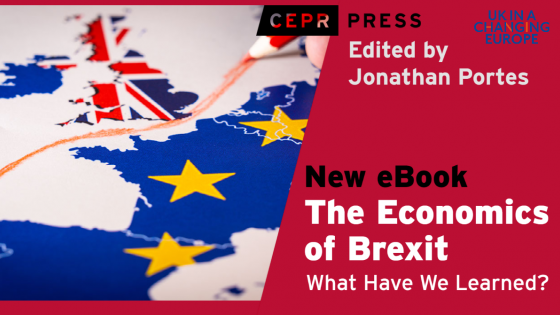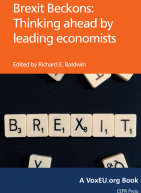Leaving the EU Single Market – not, formally, a necessary consequence of Brexit, but in practice one that became inevitable very shortly after the Brexit referendum – meant, by definition, increased barriers to trade in goods and services between the UK and the EU (and the European Economic Area), and the end of free movement of people in both directions. It also – again, not as a necessary consequence, but as part of the clear political commitments of the Vote Leave campaign and the post-2016 Conservative government – entailed a reduction of such barriers between the UK and the rest of the world (e.g. Baldwin 2016)
In other words, just as joining the EU (and the subsequent deepening of European integration) led both to trade creation – as trade between the UK and other Member States increased – and trade diversion – as UK trade with the rest of the world decreased (particularly, in the years following entry, trade with some Commonwealth countries) – Brexit should lead to the opposite: call it ‘trade destruction’ and ‘trade reversion’. Similarly with migration, although in this case it was the accession of the countries of Eastern and Central Europe to the EU in 2004 that led to a substantial reorientation of UK inward migration flows away from former Commonwealth countries and towards the EU (Portes 2015).
It follows that in theory, the overall impact on the volume of UK trade and migration from Brexit is ambiguous. However, economists were almost unanimous that it would in practice be negative. For trade, the logic was simple. The EU is by far the UK’s largest trading partner, accounting for (at the time of the referendum) about half of all UK trade; and the EU Single Market is an area of deep economic integration, much more than just a free trade area. Empirical estimates of the impact of Brexit on trade therefore suggested that reduced trade barriers to the rest of the world post-Brexit, while beneficial, would do little to outweigh the negative impacts of increased barriers with the EU (e.g. Dhringra et al. 2016).
Modelling by the UK government (DExEU 2018) estimated that, assuming a free trade agreement (FTA) with the EU that provided for tariff- and quota-free trade with the EU, but little or no regulatory convergence, meaning large increases in non-tariff barriers – which proved to be broadly the eventual outcome under the UK-EU Trade and Cooperation Agreement – UK-EU trade volumes would fall by about 25%. Meanwhile, even under optimistic assumptions about possible FTAs with non-EU countries including the US, China and India, trade volumes with the rest of the world would only increase by about 5%, resulting in a net fall of about 10%. Consistent with this, the UK Office of Budget Responsibility, based on a comprehensive review of the literature, forecast a fall in UK trade intensity of about 15% (OBR 2018).
The consensus on immigration was remarkably similar: that Brexit would lead directly, through the end of free movement, to a sharp fall in immigration from the EU, only partially offset by discretionary liberalisation to the rest of the world. Forte and Portes (2019) estimated that EU migration would fall by about 70%, while non-EU migration might increase by about 10%. However, this predated the fall of Theresa May, who had planned to implement a very restrictive new immigration system; the Johnson administration switched tack. Revised estimates (UK in a Changing Europe 2019) suggested that while EU migration would still decrease very considerably, perhaps by 60%, non-EU migration might increase by about 30%. The official Home Office impact assessment came to a similar conclusion (Home Office 2021).
So, how do these assessments compare with outcomes? On trade, at an aggregate level, the impacts are consistent with the predictions described above. UK trade performance since the implementation of the TCA has been extremely weak, with the UK largely missing out on the broad-based recovery in global trade volumes. Using a synthetic counterfactual approach, Springford (2022) estimates that Brexit has reduced UK trade in goods by about 13%. The OBR, in its latest forecast, concluded similarly that the data so far was consistent with its assumption of a 15% fall. (OBR, 2022).
However, as noted by Freeman et al (2022), closer examination reveals some puzzling aspects of the data. UK imports from the EU have fallen considerably – despite the fact that the UK has as yet not imposed the full range of regulatory checks provided for under the TCA and WTO rules – while imports from the rest of the world have risen. But exports to the EU, while weak, have moved broadly in line with those to the rest of the world; there is no obvious differential effect. Similarly, Du and Shepotylo (2022) find that Brexit has adversely affected UK service exports not just to the EU but to the rest of the world.
Figure 1 EU and non-EU goods and services trade
Source: Office of Budget Responsibility (2022).
So, while this outcome is hardly comforting for the fringe minority of economists who argued that increases in trade with the rest of the world would match or even outweigh losses from EU trade (Bootle et al. 2018), it also poses a challenge to mainstream analyses, based as they are on a combination of CGE models and standard gravity models of bilateral trade flows (OBR, 2018). It may be that, as Baldwin (2014) observed, ‘deep’ regional agreements like the EU have much more complex impacts than simply removing trade barriers, relating to the globalisation of supply chains. Indeed, Mattoo et al (2022) find that EU membership actually increases trade with non-member states. As this analysis would predict, leaving the EU does not appear to have resulted in a reorientation of UK trade away from the EU and towards the rest of the world, but rather an economy that is simply less open to trade and investment (Posen 2022).
Meanwhile, on immigration, the predicted decline in EU migration – exacerbated by the pandemic and its aftereffects – has evolved much as forecast, with net migration from the EU falling close to zero in the most recent available data. However, increases in non-EU migration have significantly exceeded expectations. The number of skilled worker visas has approximately doubled compared to pre-pandemic levels; this is driven by an increase in the number of visas granted to non-EU nationals, especially Indians, Filipinos and Nigerians, rather than the post-Brexit requirement for EU nationals to secure a visa (EU nationals only represent approximately 10% of work visas). Similarly, there have been very large falls in the number of EU nationals coming to the UK to study, more than counterbalanced by a sharp increase in non-EU nationals, with particularly large increases in those coming from India, Pakistan, and Nigeria.
Figure 2 Work-related visas granted, by visa type, year ending by quarter, June 2013 to June 2022
Source: Home Office Immigration Statistics, August 2022.
While data are patchy, overall net migration to the UK appears to be roughly similar to pre-pandemic levels, and rising. So for immigration, contrary both to forecasts and to trade patterns, ‘destruction’ of EU migration has indeed been at least offset by ‘reversion’ of non-EU migration – in large part to the ‘new Commonwealth’ [i.e. non-white] countries that were large sources of migration to the UK in the post-colonial, pre-EU era, as well as in the early 2000s.
It is relatively easy account for this in pure policy terms. As I noted at the time of its introduction (Portes 2021), the new system in principle means that more than half of all jobs in the UK labour market are open to anyone from anywhere in the world. And post-pandemic labour shortages have meant that those employers who are in a position to pay the substantial fees and navigate the required bureaucratic processes have a strong incentive to do so. Meanwhile, the introduction of a specific sub-category for workers in the health and care sector, combined with very high levels of vacancies, has led to large increases in international recruitment in this sector. This is all visible in the sectoral profile of visas issued, with the vast majority accounted for by the health sector and high-productivity, high skill service sectors such as IT, finance, business and professional services.
But the political economy of this is more complex. Many analysts assumed that UK domestic politics would ensure that Brexit, driven as it was in large part by concern over migration to the UK, did indeed deliver a significant net reduction in migration flow; and that failure to deliver this would result in a political backlash, leading to a tightening of policy. As yet, this has not materialised.
In Portes (2022b), I explore possible explanations, noting that the UK public is both far less concerned about immigration than it has been for most of the past two decades, and much more positive about both the broader economic and social impacts of migration. Meanwhile, Rolfe et al. (2022) find strong support for the three key planks of the new system: a focus on ‘control’ rather than numbers; a system which treats applicants broadly the same whatever country they come from; and one which prioritise those with skills needed by the UK labour market. There appears to be little public appetite for sharp cuts in the migration of skilled workers or international students.
Overall, then, the picture is mixed. On trade, the basic intuition that erecting new trade barriers with the UK’s largest trading partner would reduce trade remains very much intact; but the causal mechanisms look to be more complex than those in our standard models. On immigration, while correctly identifying the likely impacts – a shift from EU to non-EU, and from lower skilled to higher skilled migration – we underestimated the extent to which liberalisation would increase migration flows in the short term. And Brexit, while now ‘done’, remains a moving target for economic analysis. Future political developments – whether a trade war with the EU over the Northern Ireland Protocol, or a political backlash against immigration – could require us to revisit both our models and our assumptions.
References
Baldwin, R (2014), “Multilateralising 21st century regionalism”, VoxEU.org, 20 January.
Baldwin, R (ed) (2016), Brexit Beckons: thinking ahead from leading economists, CEPR Press.
Bootle, R, G Lyons, J Jessop and P Minford (2018), “Alternative Brexit Economic Analysis”, Economists for Free Trade.
DExEU - Department for Exiting the European Union (2018), “EU Exit: Long Term Economic Analysis”.
Dhringa, S, H Huang, G Ottaviano, T Sampson and J Van Reenen (2016), “The consequences of Brexit for UK trade and living standards”, VoxEU.org, 4 April.
Du, J and O Shepotylo (2022), “Brexit and UK services trade”, in J Portes (ed.), The Economics of Brexit: What Have We Learned?, CEPR Press.
Forte, G and J Portes (2019), “Immigration in Wales after Brexit”, Welsh Centre for Public Policy.
Freeman, R, K Manova, T Prayer and T Sampson (2022), “The impact of Brexit on UK–EU trade", in J Portes (ed.), The Economics of Brexit: What Have We Learned?, CEPR Press.
Home Office (2020), “Impact Assessment for Immigration and Social Security Co-ordination (EU Withdrawal) Bill 2020”.
Mattoo, A, A Mulabdic and M Ruta (2022), “Trade creation and trade diversion in deep agreements”, Canadian Journal of Economics 55(3).
OBR – Office of Budget Responsibility (2018), “Brexit and the OBR’s forecasts”, Discussion Paper 3.
OBR (2022), Economic and Fiscal Outlook, March 2022.
Portes, J (2021) “Immigration and the UK economy after Brexit”, VoxEU.org, 25 June.
Portes, J (2015), “Labour Mobility in the European Union”, in The New Palgrave Dictionary of Economics, Palgrave Macmillan.
Portes, J (ed.) (2022a), The Economics of Brexit: What Have We Learned?, CEPR Press, London.
Portes, J (2022b) “A reply to O’Brien on immigration”, Conservative Home, August.
Posen, A and L Rengifo-Keller (2022), "Brexit Britain in a changing global economy", in J Portes (ed.), The Economics of Brexit: What Have We Learned?, CEPR Press.
Rolfe, H, S Katwala and S Ballinger (2019), https://www.britishfuture.org/wp-content/uploads/2021/09/Immigration.A-changing-debate.pdf“Immigration: A Changing Debate”, British Future.
Springford, J (2022), “The Cost of Brexit So Far”, Centre for European Reform, June.
UK in a Changing Europe (2019), “The economic impact of Boris Johnson’s Brexit Proposals”, October.





